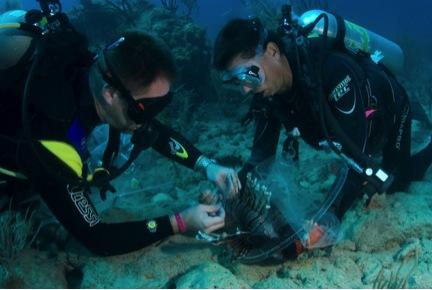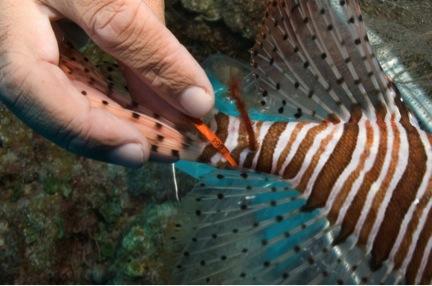Text by Erin Spencer, Photos courtesy of Lad Akins
A recent study published in Ecology and Evolution offers a new approach to traditional mark and recapture studies while providing valuable insight into the growth and movement patterns of invasive lionfish. Lad Akins, Dr. James Morris, and Dr. Stephanie Green teamed up to develop a novel way of visually tagging fish underwater, minimizing both tagging time and fish trauma.
Traditional mark and recapture studies involve bringing fish to the surface to apply tags. But this can subject fish to barotrama (stress resulting from large changes in depth) and strain from excessive handling and anesthesia, which can lead to high levels of mortality. Plus, fish are often released away from the initial capture site, potentially throwing off study results by affecting fish behavior and movement.
This new method brings the tagging process to the ocean floor. After a fish is captured and measured, one SCUBA diver holds the fish firmly on the sand while another uses an IV needle to guide a tagging needle through the tail end of the fish. The needle is then removed, leaving a small but colorful tag streaming from the tail.

To test the new method, Akins, Morris, and Green headed to the Bahamas. The team collected and tagged 161 lionfish at 26 locations in the north-central Bahamian archipelago over the span of three years; noting the size, location, and post-capture behavior of each fish. Even with the extra precautions taken to protect divers against the fish’s venomous spines, in-situ tagging proved to be much faster than traditional methods with an average of only 3 minutes between capture and release.
The team revisited study sites periodically to record the presence of tagged fish. In total, 24 percent of tagged lionfish were recovered between 8 and 188 days after tagging, a rate on par with traditional methods. Of the fish tagged on continuous coral reefs, all were found at their initial capture site. The team also determined that tagged fish grew between 0.1 and 0.6mm per day.
The results have serious implications for both tagging procedures and lionfish management. First, underwater tagging provides an effective and efficient answer to traditional tagging challenges. The method provides critical information about fish movement and growth while minimizing trauma and displacement, and could ultimately reduce the costs of data collection. Additionally, the study suggests lionfish can have high site fidelity over long periods of time, though some fish do move. This information helps determine where and when removal efforts are likely to be successful. Further in-situ tagging studies will only enhance our knowledge of invasive lionfish and how to manage them.
Read the full paper at http://onlinelibrary.wiley.com/doi/10.1002/ece3.1171/full

